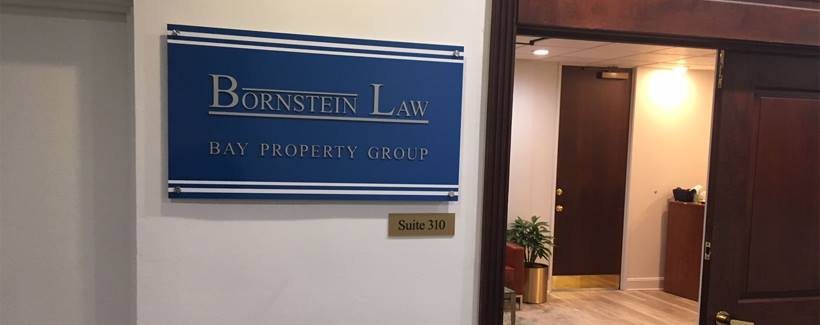It’s back to basics at Bornstein Law. While our latest articles on Oakland’s slippery slope towards expanded rent control and other posts have been reactionary, certain immutable rules do not blow in the political winds. One of them is state law concerning security deposits.
A bit of trivia: Disputes over security deposits are the most common reason why landlords are dragged over the coals in Small Claims Court, and it’s no mystery why. Rest assured, one of the first things on the mind of outgoing tenants – even before they ask themselves how to get that giant sofa around the narrow doorway – is how they are going to get their security deposit back on moving day. Yet dealing with these disputes are anything but trivial.
This topic recently graced itself in the media after a California billionaire developer has been accused of wrongly keeping millions of dollars in rental security deposits from thousands of tenants. Former tenants also claim they were not provided adequate reasons for damages in apartments when they moved out, as required by state law. Instead, reads the lawsuit, generic descriptions such as “maintenance charge,” or, “cleaning charge” are listed.
Presumably, the billionaire has some financial cushion and can take a hit, but other landlords don’t have the luxury to be so heedless – a costly lawsuit can decimate their rental business.
Security deposit rules are codified in California Civil Code Section 1950.5 and spell out four categories as lawful deductions from security deposits. Landlords may be able to keep all or a portion of the tenant’s security deposit for enumerated reasons:
- Repayment of back rent at the end of the tenancy;
- Repair damage to the unit that is not ordinary wear and tear;
- Cleaning the premises to restore it to the condition at the beginning of the tenancy; and
- to remedy other defaults that may be designated by the rental agreement.
The law cannot anticipate all circumstances, and so it’s plausible that other charges can be justified on a case-by-case basis.
What is normal wear and tear anyway?
When a tenant absolutely shredded the carpet or completely stained countertops bright red, it’s a clear reason to deduct from the tenants’ security deposit. Ditto for the condition of this apartment – when we shared this photo, it went viral.
For less egregious defects, it’s a judgment call.
Wear and tear is the average deterioration of furniture, carpets, and fixtures of a rental property due to regular use over time and although California vaguely defines this term, there is ample case law that provides guidance. Scuff marks on the wall, small chips of paint from door frames, tread and dirt in carpets, small nail holes in the wall, minor wear on appliances, and the natural decrease of useful life for appliances and carpeting can be considered the result of the tenant using the property for its intended purpose.
For those of you who are visual, we’ve put together a handy, one-page PDF that provides a framework to determine whether defects rise to the level of neglect or if blemishes are to be expected in the natural course of the tenancy.
Download our Security Deposit Deduction Guide…
Bornstein Law has a keen eye for what is reasonable wear and tear and what is not – when in doubt, please consult us first.
Security deposits can come in many shapes and forms
They can be called last month’s rent deposits, pet deposits, key deposits, and others, but don’t let these names fool you. Under the law, they are considered the security deposit period, and cannot exceed legal limits when they are all added up.
Also, keep in mind that certain courts have said itemized deposits can only be used for its stated purpose. For example, pet deposits can only be used for the damage that Fluffy wreaked in the apartment, and not for any other damages unrelated to the pet. To avoid exceeding the statutory maximum and ensure the deposit can be used towards any loss, we advise having a single security deposit.
What the landlord can ask for
California prescribes the maximum dollar amount owners can charge. For unfurnished apartments, landlords can ask for a maximum of two months’ rent if the apartment is unfurnished and up to three months’ rent if the residence is furnished. Owners are entitled to ask for an additional half-months’ rent when the tenant has a waterbed.
Although state law does not require landlords to pay a tenant interest on the retained security deposit, some rent-controlled cities do mandate this. San Francisco is in a rather exclusive club of cities that specify the interest rate to be paid. The rate of interest owed on deposits is established by the Rent Board.
A word about “non-refundable” deposits
If you have “non-refundable” deposit, for example, an automatic deduction for flea spraying if a pet was on the premises, or a deduction for painting, steam cleaning, replacing the carpets and the like, this flies in the face of the law. When a tenant complies with the lease terms, he or she is entitled to all of the security deposit back unless there was serious damage.
Move-out inspections
California has one of the most cumbersome security accounting rules. Every tenant has the right to a pre-move-out inspection on the eve of vacating the premises. If the tenant waives this right, you have no worries. However, if a tenant asserts his or right to a pre-move out inspection, he or she must be afforded the opportunity to be present during the walk-through inspection.
This exercise must take place 14 days prior to the tenant’s actual transition. Any deductions the landlord intends to take after his or her observations of the unit’s conditions must be itemized in writing. During this period of time, the tenant has the ability to remedy any itemized deductions in order to preclude the owner from taking them.
When the tenant finally delivers possession of the unit, it’s time to conduct security deposit accounting, whereby the landlord documents any deductions. Landlords have 21 days to perform this accounting and return a tenant’s security deposit in full or partially.
If any deductions are taken from the tenant’s security deposit, the partial refund check must be accompanied by a written itemized statement that lists the amounts deducted and the reasons for the deductions.
If the deduction exceeds $126, the landlord must share copies of receipts for the charges incurred to repair or clean the unit. If the tenant takes issue with deductions or he or she did not receive an itemization accompanied by receipts, they can send a letter to the landlord, and even though the tenancy has ended by this point, any correspondence should be taken seriously – if the landlord does not respond within a reasonable time, it is ripe for a Small Claims Court Action.
Parting thoughts
We remind landlords that when the carefully choreographed steps of the security deposit are ignored, liability is not limited to the dollar amount of the security deposit. Courts are all too willing to punish nonchalant owners who hold tenants hostage with the security deposit and unnecessarily pocket money just because the tenant forked it over. A phalanx of tenant attorneys will gladly help tenants settle the score.
When it comes to security deposits, documentation is specialized, timelines are unforgiving, and the rules must be followed to the letter. Bornstein Law is very good at managing landlord-tenant relationships from the cradle to the grave of the tenancy – contact our offices to avoid or resolve conflicts and cauterize risk.







